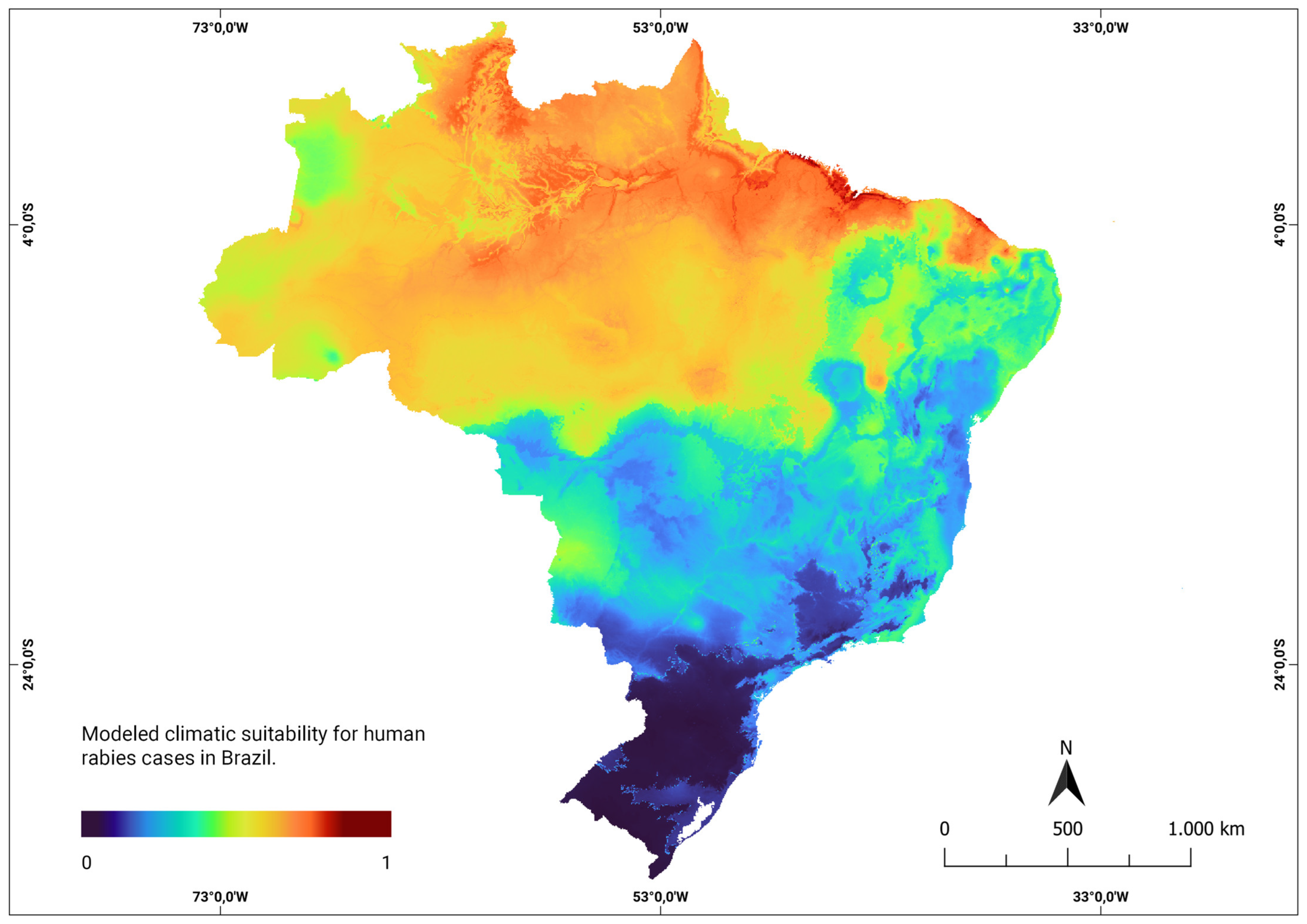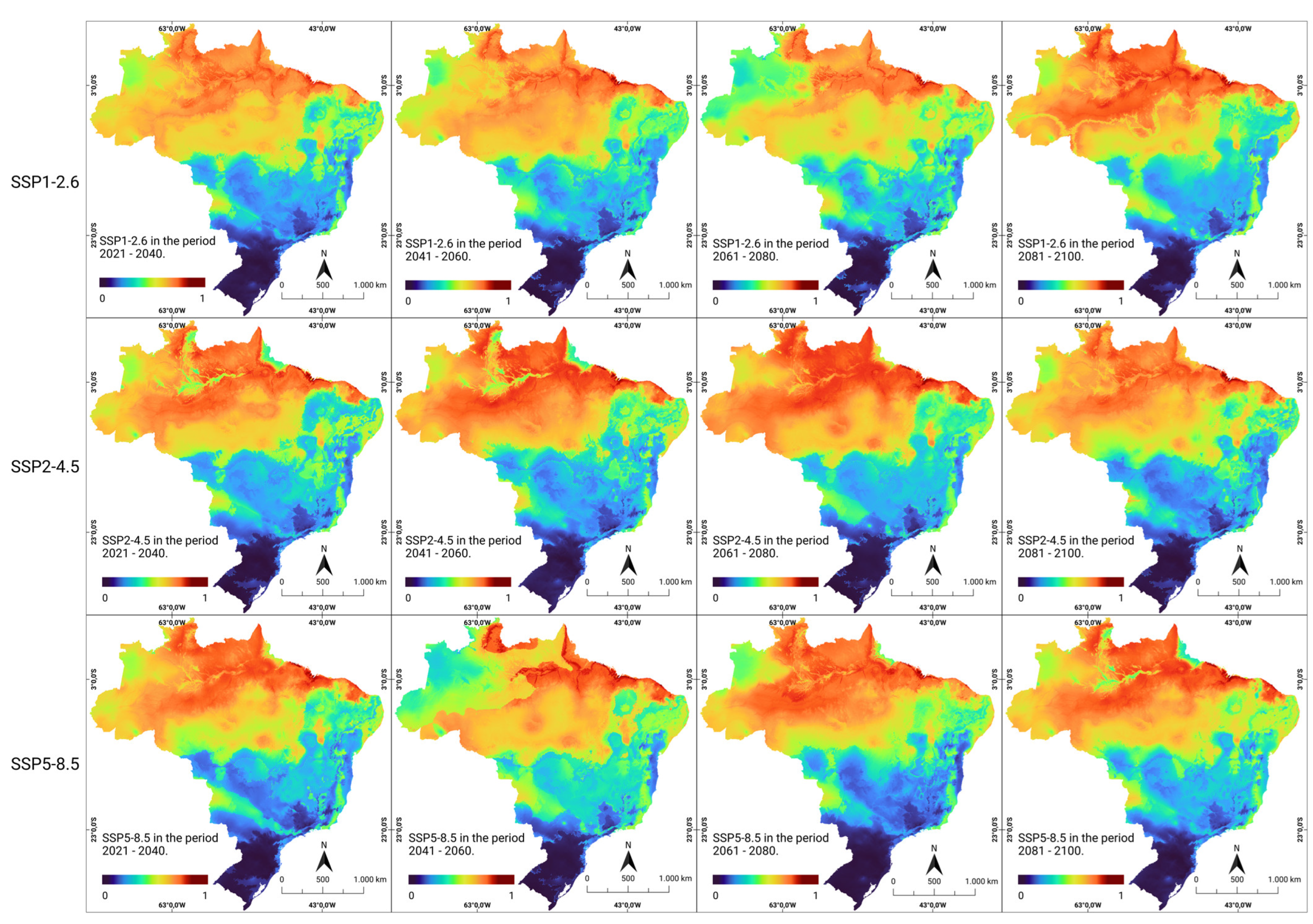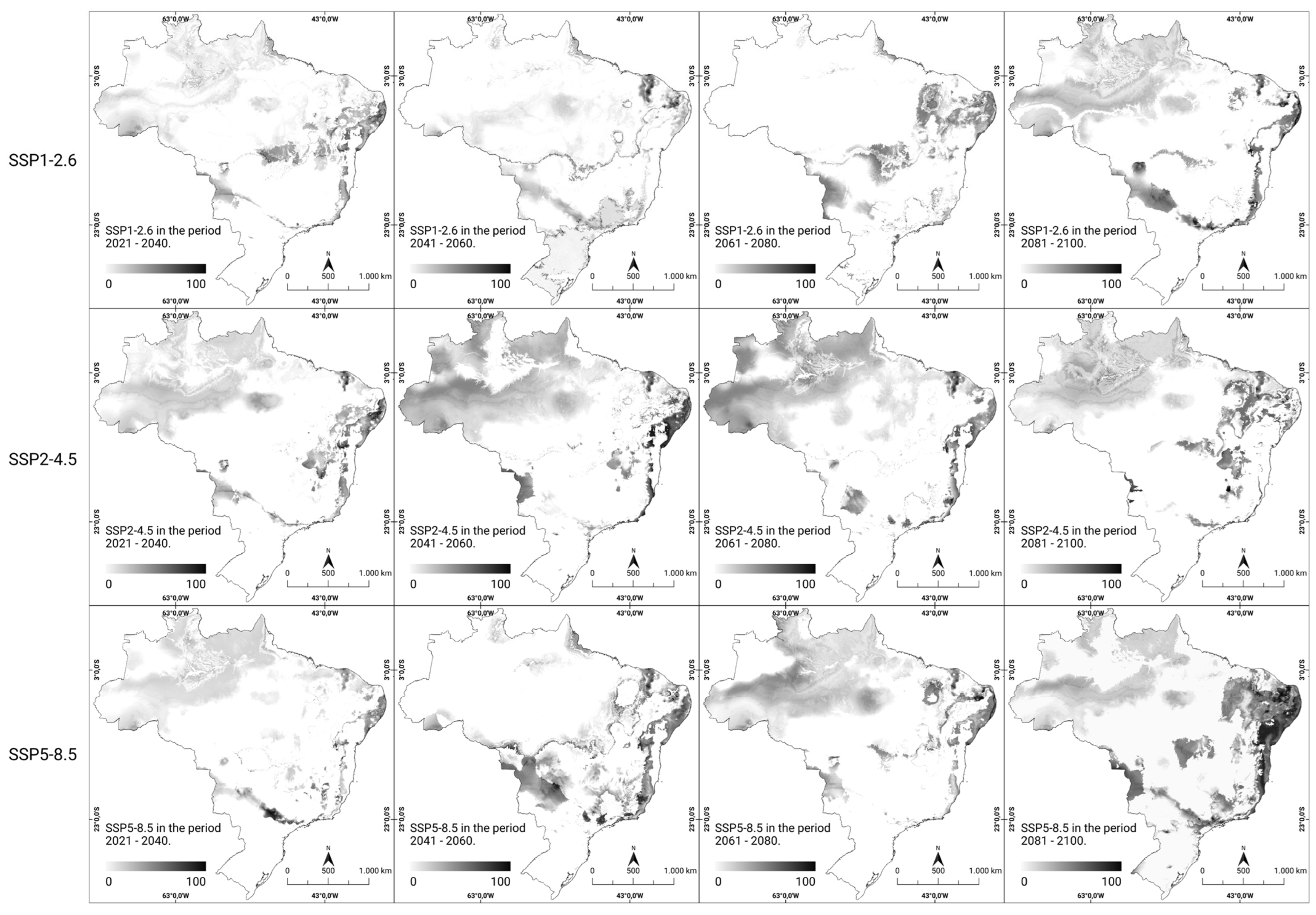Modeling of Human Rabies Cases in Brazil in Different Future Global Warming Scenarios
Abstract
1. Introduction
2. Material and Methods
2.1. Health Data
2.2. Climate Data
2.3. Data Analysis
3. Results
4. Discussion
5. Conclusions
Supplementary Materials
Author Contributions
Funding
Institutional Review Board Statement
Informed Consent Statement
Data Availability Statement
Conflicts of Interest
References
- Fisher, C.R.; Streicker, D.G.; Schnell, M.J. The spread and evolution of rabies virus: Conquering new frontiers. Nat. Rev. Microbiol. 2018, 16, 241–255. [Google Scholar] [CrossRef]
- World Health Organization. Rabies. Available online: https://www.who.int/news-room/fact-sheets/detail/rabies (accessed on 22 September 2023).
- Lim, P.L.; Barkham, T.M.S. Serologic response to rabies pre-exposure vaccination in persons with potential occupational exposure in Singapore. Int. J. Infect. Dis. 2010, 14, e511–e513. [Google Scholar] [CrossRef][Green Version]
- Sreenivasan, N.; Li, A.; Shiferaw, M.; Tran, C.H.; Wallace, R.; Blanton, J.; Knopf, L.; Abela-Ridder, B.; Hyde, T.; Working group on Rabies PEP logistics. Overview of rabies post-exposure prophylaxis access, procurement and distribution in selected countries in Asia and Africa, 2017–2018. Vaccine 2019, 37 (Suppl. S1), A6–A13. [Google Scholar] [CrossRef]
- Hampson, K.; Coudeville, L.; Lembo, T.; Sambo, M.; Kieffer, A.; Attlan, M.; Barrat, J.; Blanton, J.D.; Briggs, D.J.; Cleaveland, S.; et al. Estimating the global burden of endemic canine rabies. PLoS Negl. Trop. Dis. 2015, 9, e0003709. [Google Scholar] [CrossRef]
- World Health Organization; Food and Agriculture Organization of the United Nations (FAO); World Organisation for Animal Health (OIE). Zero by 30: The Global Strategic Plan to End Human Deaths from Dog-Mediated Rabies by 2030; WHO: Geneva, Switzerland, 2018; p. 48. Available online: https://www.woah.org/fileadmin/Home/eng/Media_Center/docs/Zero_by_30_FINAL_online_version.pdf (accessed on 24 September 2023).
- Ministério da Saúde: Brasil. Secretaria de Vigilância em Saúde. Coordenação Geral de Vigilância de Zoonoses e Doenças de Transmissão Vetorial. Guia de Vigilância em Saúde, 5th ed.; Ministério da Saúde: Brasília, Brazil, 2022. Available online: https://bvsms.saude.gov.br/bvs/publicacoes/guia_vigilancia_saude_5ed_rev_atual.pdf (accessed on 2 October 2023).
- Ministério da Saúde: Brasil. Secretaria de Vigilância em Saúde. Raiva: O que é, Causas, Sintomas, Tratamento, Diagnóstico e Prevenção. 2020. Available online: https://www.gov.br/saude/pt-br/assuntos/saude-de-a-a-z/r/raiva (accessed on 20 September 2023).
- Vigilato, M.A.; Clavijo, A.; Knobl, T.; Silva, H.M.; Cosivi, O.; Schneider, M.C.; Leanes, L.F.; Belotto, A.J.; Espinal, M.A. Progress towards eliminating canine rabies: Policies and perspectives from Latin America and the Caribbean. Philos. Trans. R. Soc. B Biol. Sci. 2013, 368, 20120143. [Google Scholar] [CrossRef]
- Vargas, A.; Romano, A.P.M.; Merchán-Hamann, E. Raiva humana no Brasil: Estudo descritivo, 2000–2017. Epidemiol. Serv. Saúde 2019, 28, 1–9. [Google Scholar] [CrossRef]
- Sodré, M.M.; da Gama, A.R.; de Almeida, M.F. Updated list of bat species positive for rabies in Brazil. Rev. Inst. Med. Trop. São Paulo 2010, 52, 75–81. [Google Scholar] [CrossRef]
- de Carvalho, R.B.H.B.; Franco, A.C.; Roehe, P.M. Raiva: Uma breve revisão. de Recuperado. Acta Sci. Vet. 2007, 35, 125–144. Available online: https://www.redalyc.org/articulo.oa?id=289021845001 (accessed on 21 September 2023).
- de Andrade, F.A.G.; Gomes, M.N.; Uieda, W.; Begot, A.L.; Ramos, O.S.; Fernandes, M.E.B. Geographical analysis for detecting high-risk areas for bovine/human rabies transmitted by the common hematophagous bat in the Amazon region. Brazil. PLoS ONE 2016, 11, e0157332. [Google Scholar] [CrossRef] [PubMed]
- Ferreira, R.S.; Almeida, R.M.A.; Nogueira, D.A.; Oliveira, N.M.S.; Fiorini, J.E. Bovine rabies incidence in the State of Minas Gerais/Brazil, between 2002 and 2006. Arq. Inst. Biol. 2012, 79, 287–291. [Google Scholar] [CrossRef]
- Belotto, A.; Leanes, L.F.; Schneider, M.C.; Tamayo, H.; Correa, E. Overview of rabies in the Americas. Virus Res. 2005, 111, 5–12. [Google Scholar] [CrossRef] [PubMed]
- Mantovan, K.B.; Menozzi, B.D.; Paiz, L.M.; Sevá, A.P.; Brandão, P.E.; Langoni, H. Geographic distribution of common vampire bat Desmodus rotundus (Chiroptera: Phyllostomidae) shelters: Implications for the spread of rabies virus to cattle in Southeastern Brazil. Pathogens 2022, 11, 942. [Google Scholar] [CrossRef]
- Ferraz, C.; Achkar, S.M.; Kotait, I. First report of rabies in vampire bats (Desmodus rotundus) in an urban area, Ubatuba, São Paulo state, Brazil. Rev. Inst. Med. Trop. São Paulo 2007, 49, 389–390. [Google Scholar] [CrossRef] [PubMed][Green Version]
- de Almeida, M.F.; da Rosa, A.R.; Sodré, M.M.; Martorelli, L.F.A.; Netto, J.T. Fauna de morcegos (Mammalia, Chiroptera) e a ocorrência de vírus da raiva na cidade de São Paulo, Brasil. Vet. Zootec. 2015, 22, 89–100. Available online: https://rvz.emnuvens.com.br/rvz/article/view/958 (accessed on 21 September 2023).
- Ribeiro, J.; Staudacher, C.; Martins, C.M.; Ullmann, L.S.; Ferreira, F.; Araujo, J.P.; Biondo, A.W. Bat rabies surveillance and risk factors for rabies spillover in an urban area of Southern Brazil. BMC Vet. Res. 2018, 14, 173. [Google Scholar] [CrossRef] [PubMed]
- Rocha, F.; Dias, R.A. The common vampire bat Desmodus rotundus (Chiroptera: Phyllostomidae) and the transmission of the rabies virus to livestock: A contact network approach and recommendations for surveillance and control. Prev. Vet. Med. 2020, 174, 104809. [Google Scholar] [CrossRef]
- Oro, D.; Genovart, M.; Tavecchia, G.; Fowler, M.S.; Martínez-Abraín, A. Ecological and evolutionary implications of food subsidies from humans. Ecol. Lett. 2013, 16, 1501–1514. [Google Scholar] [CrossRef]
- Favoretto, S.R.; de Mattos, C.C.; de Mattos, C.A.; Campos, A.C.; Sacramento, D.R.; Durigon, E.L. The emergence of wildlife species as a source of human rabies infection in Brazil. Epidemiol. Infect. 2013, 141, 1552–1561. [Google Scholar] [CrossRef]
- Moutinho, F.F.B.; Nunes, V.M.A.; Fernandes, P.M.; Borges, F.V.B.; Faria Neto, F.D. Surto de raiva em morcegos frugívoros no município de Niterói, RJ, 2018. Med. Vet. 2020, 14, 307–314. [Google Scholar] [CrossRef]
- Jones, G.; Rebelo, H. Responses of bats to climate change: Learning from the past and predicting the future. Bat Evol. Ecol. Conserv. 2013, 457–478. [Google Scholar] [CrossRef]
- Sherwin, H.A.; Montgomery, W.I.; Lundy, M.G. The impact and implications of climate change for bats. Mamm. Rev. 2013, 43, 171–182. [Google Scholar] [CrossRef]
- Adams, R.A.; Hayes, M.A. Water availability and successful lactation by bats as related to climate change in arid regions of western North America. J. Anim. Ecol. 2008, 77, 1115–1121. [Google Scholar] [CrossRef]
- Wu, H.; Gong, L.; Jiang, T.; Feng, J.; Lin, A. Echolocation call frequencies of bats vary with body temperature and weather conditions. Anim. Behav. 2021, 180, 51–61. [Google Scholar] [CrossRef]
- Hayes, M.A.; Adams, R.A. Simulated bat populations erode when exposed to climate change projections for western North America. PLoS ONE 2017, 12, e0180693. [Google Scholar] [CrossRef] [PubMed]
- Lee, D.N.; Papeş, M.; Van den Bussche, R.A. Present and potential future distribution of common vampire bats in the Americas and the associated risk to cattle. PLoS ONE 2012, 7, e42466. [Google Scholar] [CrossRef] [PubMed]
- Hutter, S.E.; Käsbohrer, A.; González, S.L.F.; León, B.; Brugger, K.; Baldi, M.; Mario Romero, L.; Gao, Y.; Chaves, L.F. Assessing changing weather and the El Niño Southern Oscillation impacts on cattle rabies outbreaks and mortality in Costa Rica (1985–2016). BMC Vet. Res. 2018, 14, 285. [Google Scholar] [CrossRef]
- Ancillotto, L.; Santini, L.; Ranc, N.; Maiorano, L.; Russo, D. Extraordinary range expansion in a common bat: The potential roles of climate change and urbanisation. Naturwissenschaften 2016, 103, 15. [Google Scholar] [CrossRef]
- Rebelo, H.; Tarroso, P.; Jones, G. Predicted impact of climate change on European bats in relation to their biogeographic patterns. Glob. Chang. Biol. 2010, 16, 561–576. [Google Scholar] [CrossRef]
- Rulli, M.C.; D’Odorico, P.; Galli, N.; Hayman, D.T.S. Land-use change and the livestock revolution increase the risk of zoonotic coronavirus transmission from rhinolophid bats. Nat. Food 2021, 2, 409–416. [Google Scholar] [CrossRef]
- Mistry, S.; Moreno-Valdez, A. Climate Change and Bats: Vampire Bats Offer Clues to the Future. Bats 2008, 26, 8–11. [Google Scholar]
- Zarza, H.; Martínez-Meyer, E.; Suzán, G.; Ceballos, G. Geographic distribution of Desmodus rotundus in Mexico under current and future climate change scenarios: Implications for bovine paralytic rabies infection. Vet. México OA 2017, 4, 10–25. [Google Scholar] [CrossRef]
- Mayen, F. Haematophagous bats in Brazil, their role in rabies transmission, impact on public health, livestock industry and alternatives to an indiscriminate reduction of bat population. J. Vet. Med. B Infect. Dis. Vet. Public Health 2003, 50, 469–472. [Google Scholar] [CrossRef] [PubMed]
- Peterson, A.T. Ecologic niche modeling and spatial patterns of disease transmission. Emerg. Infect. Dis. 2006, 12, 1822–1826. [Google Scholar] [CrossRef] [PubMed]
- Hayes, M.A.; Piaggio, A.J. Assessing the potential impacts of a changing climate on the distribution of a rabies virus vector. PLoS ONE 2018, 13, e0192887. [Google Scholar] [CrossRef] [PubMed]
- Tabnet–DATASUS. (n.d.). 2024. Available online: https://datasus.saude.gov.br/home/tabnet/ (accessed on 18 January 2023).
- Malha Municipal|IBGE. 2024. Available online: https://www.ibge.gov.br/geociencias/organizacao-do-territorio/malhas-territoriais/15774-malhas.html (accessed on 18 January 2023).
- Brasil. Ministério das Rel Exteriores. Geografia: Dados Geográficos do Brasil. 2022. Available online: https://www.gov.br/mre/pt-br/embaixada-bogota/o-brasil/geografia (accessed on 19 October 2023).
- Fick, S.E.; Hijmans, R.J. WorldClim 2: New 1-km spatial resolution climate surfaces for global land areas. Int. J. Climatol. 2017, 37, 4302–4315. [Google Scholar] [CrossRef]
- Salami, A.; Fakih, H.; Chakkour, M.; Salloum, L.; Bahmad, H.F.; Ghssein, G. Prevalence, risk factors and seasonal variations of different Enteropathogens in Lebanese hospitalized children with acute gastroenteritis. BMC Pediatr. 2019, 19, 137. [Google Scholar] [CrossRef] [PubMed]
- Met Office. HadGEM3 Family: Met Office Climate Prediction Model. Available online: https://www.metoffice.gov.uk/research/approach/modelling-systems/unified-model/climate-models/hadgem3 (accessed on 19 October 2023).
- Riahi, K.; Van Vuuren, D.P.; Kriegler, E.; Edmonds, J.; O’Neill, B.C.; Fujimori, S.; Bauer, N.; Calvin, K.; Dellink, R.; Fricko, O.; et al. The Shared Socioeconomic Pathways and their energy, land use, and greenhouse gas emissions implications: An overview. Glob. Environ. Chang. 2017, 42, 153–168. [Google Scholar] [CrossRef]
- Qiao, H.; Lin, C.; Jiang, Z.; Ji, L. Marble Algorithm: A solution to estimating ecological niches from presence-only records. Sci. Rep. 2015, 5, 14232. [Google Scholar] [CrossRef]
- Thuiller, W.; Georges, D.; Engler, R.; Breiner, F.; Georges, M.D.; Thuiller, C.W. Package “biomod2”. Species Distrib. Model within Ensemble Forecast. Framew 2016, 1–136. [Google Scholar]
- O’Neill, B.C.; Kriegler, E.; Ebi, K.L.; Kemp-Benedict, E.; Riahi, K.; Rothman, D.S.; van Ruijven, B.J.; van Vuuren, D.P.; Birkmann, J.; Kok, K.; et al. The roads ahead: Narratives for shared socioeconomic pathways describing world futures in the 21st century. Glob. Environ. Chang. 2017, 42, 169–180. [Google Scholar] [CrossRef]
- Hao, T.; Elith, J.; Guillera-Arroita, G.; Lahoz-Monfort, J.J.; Serra-Diaz, J. A review of evidence about use and performance of species distribution modelling ensembles like BIOMOD. Divers. Distrib. 2019, 25, 839–852. [Google Scholar] [CrossRef]
- El-Sayed, A.; Kamel, M. Climatic changes and their role in emergence and re-emergence of diseases. Environ. Sci. Pollut. Res. Int. 2020, 27, 22336–22352. [Google Scholar] [CrossRef]
- Razgour, O.; Kasso, M.; Santos, H.; Juste, J. Up in the air: Threats to Afromontane biodiversity from climate change and habitat loss revealed by genetic monitoring of the Ethiopian Highlands bat. Evol. Appl. 2021, 14, 794–806. [Google Scholar] [CrossRef]
- Huettmann, F.; Magnuson, E.E.; Hueffer, K. Ecological niche modeling of rabies in the changing Arctic of Alaska. Acta Vet. Scand. 2017, 59, 18. [Google Scholar] [CrossRef]
- Huettmann, F.; Hueffer, K. The ecological niche of reported rabies cases in Canada is similar to Alaska. Zoonoses Public Health 2021, 68, 677–683. [Google Scholar] [CrossRef]
- Quiner, C.A.; Nakazawa, Y. Ecological niche modeling to determine potential niche of vaccinia virus: A case only study. Int. J. Health Geogr. 2017, 16, 28. [Google Scholar] [CrossRef] [PubMed]
- McNab, B.K. Energetics and the distribution of vampires. J. Mammal. 1973, 54, 131–144. [Google Scholar] [CrossRef]
- Delpietro, H.A.; Marchevsky, N.; Simonetti, E. Relative population densities and predation of the common vampire bat (Desmodus rotundus) in natural and cattle-raising areas in north-east Argentina. Prev. Vet. Med. 1992, 14, 13–20. [Google Scholar] [CrossRef]
- McNab, B.K. The economics of temperature regulation in neutropical bats. Comp. Biochem. Physiol. 1969, 31, 227–268. [Google Scholar] [CrossRef]
- Arellano-Sota, C. Vampire bat-transmitted rabies in cattle. Rev. Infect. Dis. 1988, 10 (Suppl. S4), S707–S709. [Google Scholar] [CrossRef] [PubMed]
- Kürten, L.; Schmidt, U. Thermoperception in the common vampire bat (Desmodus rotundus). J. Comp. Physiol. 1982, 146, 223–228. [Google Scholar] [CrossRef]
- Voigt, C.C.; Schneeberger, K.; Voigt-Heucke, S.L.; Lewanzik, D. Rain increases the energy cost of bat flight. Biol. Lett. 2011, 7, 793–795. [Google Scholar] [CrossRef]
- Trajano, E. Movements of cave bats in Southeastern Brazil, with emphasis on the population ecology of the common vampire bat, Desmodus rotundus (Chiroptera). Biotropica 1996, 28, 121. [Google Scholar] [CrossRef]
- Portella, D.A.P.; Blanco, L.; de Mello Filho, M.E.T.; dos Santos, J.L.A. Importância da Amazônia na dinâmica climática do centro-sul brasileiro: Influência nas dinâmicas ambientais e socioeconômicas. Geoensaios 2022, 9, 66–86. [Google Scholar] [CrossRef]
- Cavalieri, H.; Cario, S.A.F.; Fernandes, R.L. Estrutura industrial brasileira e de Santa Catarina: Alguns indícios de desindustrialização. Indicadores Econômicos FEE 2013, 40, 81–104. [Google Scholar]
- Botto Nuñez, G.; Becker, D.J.; Plowright, R.K. The emergence of vampire bat rabies in Uruguay within a historical context. Epidemiol. Infect. 2019, 147, e180. [Google Scholar] [CrossRef]
- Botto Nuñez, G.; Becker, D.J.; Lawrence, R.L.; Plowright, R.K. Synergistic effects of grassland fragmentation and temperature on bovine rabies emergence. EcoHealth 2020, 17, 203–216. [Google Scholar] [CrossRef] [PubMed]
- Bastos, V.; Mota, R.; Guimarães, M.; Richard, Y.; Lima, A.L.; Casseb, A.; Barata, G.C.; Andrade, J.; Casseb, L.M.N. Challenges of rabies surveillance in the eastern Amazon: The need of a one health approach to predict rabies spillover. Front. Public Health 2021, 9, 624574. [Google Scholar] [CrossRef]
- da Rosa, E.S.; Kotait, I.; Barbosa, T.F.; Carrieri, M.L.; Brandão, P.E.; Pinheiro, A.S.; Begot, A.L.; Wada, M.Y.; de Oliveira, R.C.; Grisard, E.C.; et al. Bat-transmitted human rabies outbreaks, Brazilian Amazon. Emerg. Infect. Dis. 2006, 12, 1197–1202. [Google Scholar] [CrossRef]
- Tolentino Júnior, D.S.; Marques, M.S.V.; Krummenauer, A.; Duarte, M.M.S.; Rocha, S.M.; de Brito, M.G.; de Santana, L.F.; de Oliveira, R.C.; de Assis, E.M.; de Sousa Cavalcante, K.K.; et al. Rabies outbreak in Brazil: First case series in children from an indigenous village. Infect. Dis. Pover 2023, 12, 78. [Google Scholar] [CrossRef] [PubMed]
- Romero-Sandoval, N.; Escobar, N.; Utzet, M.; Feijoo-Cid, M.; Martin, M. Sylvatic rabies and the perception of vampire bat activity in communities in the Ecuadorian Amazon. Cad. Saúde Pública 2014, 30, 669–674. [Google Scholar] [CrossRef]
- Fernandes, M.E.; Costa, L.J.; Andrade, F.A.; Silva, L.P. Rabies in humans and non-human in the state of Pará, Brazilian Amazon. Braz. J. Infect. Dis. 2013, 17, 251–253. [Google Scholar] [CrossRef] [PubMed]
- Sodré, D.N.A.; Rossi, G.A.M.; Mathias, L.A.; de Andrade Belo, M.A. Epidemiology and control of rabies in cattle and equines in Rondônia State, a Brazilian’s legal Amazon area. Animals 2023, 13, 2974. [Google Scholar] [CrossRef] [PubMed]
- Ribeiro, J.; Vieira, R.G.V.; Martins, C.M.; Ferreira, F.; Araujo, J.P.; Ullmann, L.S.; Dos Santos, A.P.; Biondo, A.W. Spatial distribution of bat shelters and livestock rabies in Southern Brazil. Vector-Borne Zoonotic Dis. 2021, 21, 785–795. [Google Scholar] [CrossRef] [PubMed]
- Smith, G.C. The role of modelling in predicting rabies and understanding the impact of control measures. Rev. Sci. Tech. 2018, 37, 551–557. (In English) [Google Scholar] [CrossRef]
- Wu, X.; Lu, Y.; Zhou, S.; Chen, L.; Xu, B. Impact of climate change on human infectious diseases: Empirical evidence and human adaptation. Environ. Int. 2016, 86, 14–23. [Google Scholar] [CrossRef]
- Van de Vuurst, P.; Escobar, L.E. Climate change and infectious disease: A review of evidence and research trends. Infect. Dis. Poverty 2023, 12, 51. [Google Scholar] [CrossRef]




| Dependent Variables | Bioclimatic Variables | Statistical Algorithms | ||||||
|---|---|---|---|---|---|---|---|---|
| GLM | GAM | CTA | FDA | MARS | RF | MAXENT | ||
| Rabies Human | Temperature seasonality (BIO4) | 0.514 | 0.447 | 0.721 | 0.427 | 0.258 | 0.706 | 0.266 |
| Minimum temperature of the coldest month (BIO6) | 0.083 | 0.330 | 0.532 | 0.246 | 0.414 | 0.483 | 0.176 | |
| Precipitation seasonality (BIO15) | 0.019 | 0.216 | 0.245 | 0.141 | 0.186 | 0.578 | 0.122 | |
Disclaimer/Publisher’s Note: The statements, opinions and data contained in all publications are solely those of the individual author(s) and contributor(s) and not of MDPI and/or the editor(s). MDPI and/or the editor(s) disclaim responsibility for any injury to people or property resulting from any ideas, methods, instructions or products referred to in the content. |
© 2024 by the authors. Licensee MDPI, Basel, Switzerland. This article is an open access article distributed under the terms and conditions of the Creative Commons Attribution (CC BY) license (https://creativecommons.org/licenses/by/4.0/).
Share and Cite
Neves, J.M.M.; Belo, V.S.; Catita, C.M.S.; Oliveira, B.F.A.d.; Horta, M.A.P. Modeling of Human Rabies Cases in Brazil in Different Future Global Warming Scenarios. Int. J. Environ. Res. Public Health 2024, 21, 212. https://doi.org/10.3390/ijerph21020212
Neves JMM, Belo VS, Catita CMS, Oliveira BFAd, Horta MAP. Modeling of Human Rabies Cases in Brazil in Different Future Global Warming Scenarios. International Journal of Environmental Research and Public Health. 2024; 21(2):212. https://doi.org/10.3390/ijerph21020212
Chicago/Turabian StyleNeves, Jessica Milena Moura, Vinicius Silva Belo, Cristina Maria Souza Catita, Beatriz Fátima Alves de Oliveira, and Marco Aurelio Pereira Horta. 2024. "Modeling of Human Rabies Cases in Brazil in Different Future Global Warming Scenarios" International Journal of Environmental Research and Public Health 21, no. 2: 212. https://doi.org/10.3390/ijerph21020212
APA StyleNeves, J. M. M., Belo, V. S., Catita, C. M. S., Oliveira, B. F. A. d., & Horta, M. A. P. (2024). Modeling of Human Rabies Cases in Brazil in Different Future Global Warming Scenarios. International Journal of Environmental Research and Public Health, 21(2), 212. https://doi.org/10.3390/ijerph21020212







